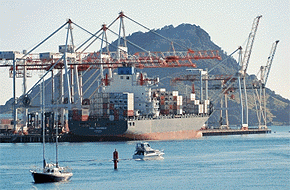
New Zealand’s terms of trade jumped 4.9% in the June quarter following a 4.2% rise in the March quarter.
This was due to rising export prices and falling import prices, Stats NZ said today.
Terms of trade is a measure of the purchasing power of New Zealand’s exports abroad. An increase means that New Zealand can buy more imports for the same amount of exports. The terms of trade rose for the second consecutive quarter but is still 2.5% below the 37-year high reached two years ago.
“The terms of trade increase ... reflected higher dairy prices", prices manager Chris Pike said. "Without dairy, the terms of trade would have risen 1.6%.”
Excluding dairy, export prices rose a mere 0.1% in the quarter, as a 4.2% lift in forestry prices was offset by weakness in meat and aluminium prices (down 2.2% and 2.6% respectively).
Import prices fell 1.5% in June, their fourth consecutive quarterly decline. Not only has the New Zealand dollar’s appreciation kept import prices at bay, but underlying world prices have also been subdued.
Downward pressure has been particularly evident for heavy manufactured goods, with electrical machinery and transport equipment prices both falling a further 2.2% in June.
There was no market reaction following the release.
Infometrics says it expects that exports of both meat and dairy will recover in the coming quarters following volume declines on Q2.
The data will boost national income, says ASB economist Christina Leung:
As expected, a large part of the decline in export volumes over Q2 reflected the effects of the drought. While milk production have started to recover in recent months and will likely flow through to some recovery in dairy export volumes, we expect meat export volumes will be weighed down by lower livestock numbers in the wake of the drought. Beyond these short-term disruptions, the medium-term outlook for export growth is mildly positive as global demand continues to grow. In particular, China’s expanding middle class is likely to underpin increased demand for our meat and dairy exports. Meanwhile, stronger domestic demand is likely to drive a continued recovery in imports.
Nathan Penny, Westpac's rural economist sees the terms of trade getting better as the year progresses. He said "With more of the recent dairy price surge to come through, we expect the terms of trade to hit a 40-year high in the September quarter, and then to remain high into 2014."
JPMorgan economist Ben Jarman points out the very weak volume growth in exports, attributing the strength in pricing to Fonterra's dominance.
As we have noted in reporting on monthly merchandise trade outcomes, nominal revenues in the NZ export sector have held in well during the supply shock. Monopolists are fortunate in that negative productivity shocks tend to come with offsetting price tailwinds, and this has relieved the overall pressure on farm income through the first half of this year. This fact also explains why there has been little evidence of income weakness (in fact, more the opposite) spilling over to other indicators like retail sales and consumer confidence.





We welcome your comments below. If you are not already registered, please register to comment.
Remember we welcome robust, respectful and insightful debate. We don't welcome abusive or defamatory comments and will de-register those repeatedly making such comments. Our current comment policy is here.